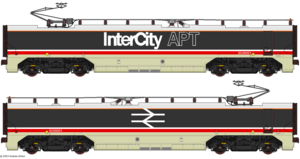| British Rail Class 370 Advanced Passenger Train – Prototype | |
|---|---|
 Class 370 at Carlisle | |
 First-class saloon in a preserved vehicle. (The plain blue seat covers are post-withdrawal replacements for the original tartan material.) | |
| In service | 1980–1986 |
| Manufacturer | British Rail Engineering Limited |
| Built at | Derby Works[1] |
| Family name | Advanced Passenger Train |
| Constructed | 1977–1980[2] |
| Entered service | 1979[3] |
| Number built | 3 full sets (6 units plus 2 spare vehicles)[3] |
| Number preserved | 7 vehicles |
| Formation | 7 cars per unit: DTS-TS-TRSB-TU-TF-TBF-M (full set is 2 units back-to-back) |
| Diagram |
|
| Fleet numbers | 370001–370006[3] |
| Operator(s) | British Rail InterCity |
| Depot(s) | Shields Road (Glasgow)[4] |
| Line(s) served | West Coast Main Line |
| Specifications | |
| Car body construction | |
| Train length | 147 m (482 ft)[5] |
| Car length |
|
| Width | 2.720 m (8 ft 11.1 in) |
| Height |
|
| Wheelbase |
|
| Maximum speed | 125 mph (200 km/h) |
| Weight |
|
| Traction motors | 4 × ASEA LJMA 410 F |
| Power output | 3,000 kW (4,000 hp) continuous |
| Electric system(s) | 25 kV 50 Hz AC overhead |
| Current collection method | Pantograph |
| UIC classification | 2′(2′)(2′)(2′)(2′)(2′)2′+Bo′Bo′ |
| Bogies |
|
| Minimum turning radius | 91 m (300 ft) |
| Braking system(s) | Hydraulic and hydrokinetic[6] |
| Safety system(s) | |
| Multiple working | Within class (max. 2 units) |
| Track gauge | 1,435 mm (4 ft 8 1⁄2 in) standard gauge |
| Notes | |
| Specifications given for seven-car units as at August 1981,[8] except where otherwise noted. A full set train would be formed of two units coupled back-to-back. | |


British Rail's Class 370 tilting trains, also referred to as APT-P (meaning Advanced Passenger Train Prototype), were the pre-production Advanced Passenger Train units. Unlike the earlier experimental gas-turbine APT-E unit, these units were powered by 25kV AC overhead electrification and were used on the West Coast Main Line between London Euston and Glasgow Central. The APT-P is the most powerful domestic train to have operated in Britain, the eight traction motors fitted to the two central Motor Cars giving a total output of 8,000 hp. This enabled the train to set the UK rail speed record of 162.2 mph in December 1979, a record that stood for 23 years.[9]
- ↑ "Advanced Passenger Train – Prototype". The Crewe Heritage Centre. Archived from the original on 24 June 2015. Retrieved 1 December 2015.
- ↑ "BR, Class 370 Advanced Passenger Train Non-Driving Motor (NDM), 49004, Era 7". Hornby.com. Retrieved 24 February 2021.
- ↑ 3.0 3.1 3.2 Marsden 1983, pp. 119–120
- ↑ Coxon, Dave. "High speed pantograph testing in Scotland in October 1983". Testing Times. Retrieved 10 February 2023.
- ↑ Boocock & Newman 1976, p. 660, Table 1.
- ↑ British Rail's Advanced Passenger Train – InterCity APT (PDF). Derby: Chief Mechanical & Electrical Engineers' Department, British Railways Board. 1979. GM869/A10/1279. Retrieved 10 February 2023.
- ↑ Tomorrow's train, today (PDF). London: British Railways Board. 1980. GM1000/A7/980. Retrieved 10 February 2023.
- ↑ Vehicle Diagram Book No. 210 for Electric Multiple Units (including A.P.T.) (PDF). Derby: Mechanical & Electrical Engineering Department, British Railways Board. LC501, LE201, LH101, LH201, LH401, LJ101, LK201 (in work pp. 428–441). Archived from the original (PDF) on 21 January 2015. Retrieved 10 February 2023 – via Barrowmore MRG.
- ↑ "Train smashes speed record". 30 July 2003 – via news.bbc.co.uk.
